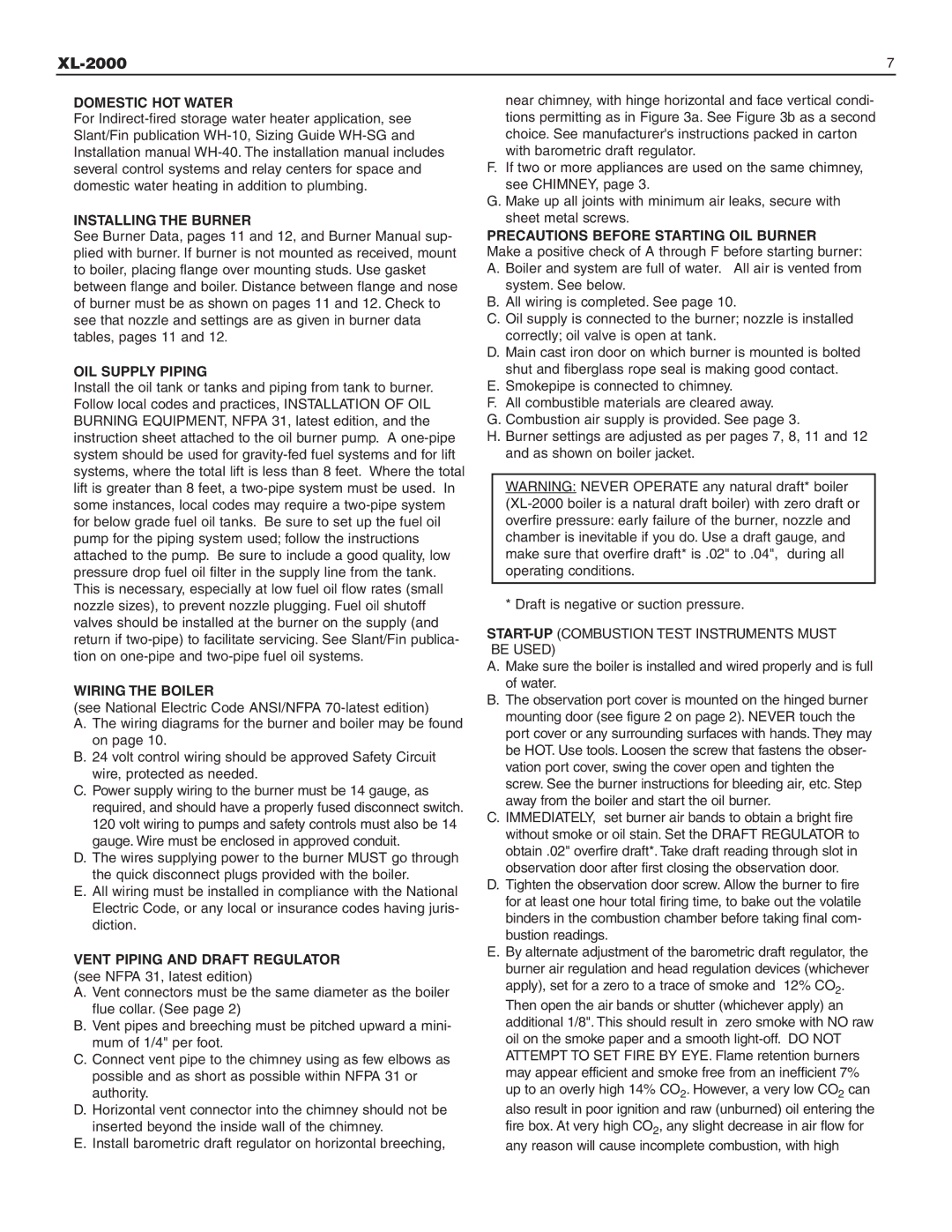
| 7 |
DOMESTIC HOT WATER
For
INSTALLING THE BURNER
See Burner Data, pages 11 and 12, and Burner Manual sup- plied with burner. If burner is not mounted as received, mount to boiler, placing flange over mounting studs. Use gasket between flange and boiler. Distance between flange and nose of burner must be as shown on pages 11 and 12. Check to see that nozzle and settings are as given in burner data tables, pages 11 and 12.
OIL SUPPLY PIPING
Install the oil tank or tanks and piping from tank to burner. Follow local codes and practices, INSTALLATION OF OIL BURNING EQUIPMENT, NFPA 31, latest edition, and the instruction sheet attached to the oil burner pump. A
WIRING THE BOILER
(see National Electric Code ANSI/NFPA
A.The wiring diagrams for the burner and boiler may be found on page 10.
B.24 volt control wiring should be approved Safety Circuit wire, protected as needed.
C.Power supply wiring to the burner must be 14 gauge, as required, and should have a properly fused disconnect switch. 120 volt wiring to pumps and safety controls must also be 14 gauge. Wire must be enclosed in approved conduit.
D.The wires supplying power to the burner MUST go through the quick disconnect plugs provided with the boiler.
E.All wiring must be installed in compliance with the National Electric Code, or any local or insurance codes having juris- diction.
VENT PIPING AND DRAFT REGULATOR (see NFPA 31, latest edition)
A.Vent connectors must be the same diameter as the boiler flue collar. (See page 2)
B.Vent pipes and breeching must be pitched upward a mini- mum of 1/4" per foot.
C.Connect vent pipe to the chimney using as few elbows as possible and as short as possible within NFPA 31 or authority.
D.Horizontal vent connector into the chimney should not be inserted beyond the inside wall of the chimney.
E.Install barometric draft regulator on horizontal breeching,
near chimney, with hinge horizontal and face vertical condi- tions permitting as in Figure 3a. See Figure 3b as a second choice. See manufacturer's instructions packed in carton with barometric draft regulator.
F.If two or more appliances are used on the same chimney, see CHIMNEY, page 3.
G.Make up all joints with minimum air leaks, secure with sheet metal screws.
PRECAUTIONS BEFORE STARTING OIL BURNER
Make a positive check of A through F before starting burner: A. Boiler and system are full of water. All air is vented from
system. See below.
B.All wiring is completed. See page 10.
C.Oil supply is connected to the burner; nozzle is installed correctly; oil valve is open at tank.
D.Main cast iron door on which burner is mounted is bolted shut and fiberglass rope seal is making good contact.
E.Smokepipe is connected to chimney.
F.All combustible materials are cleared away.
G.Combustion air supply is provided. See page 3.
H.Burner settings are adjusted as per pages 7, 8, 11 and 12 and as shown on boiler jacket.
WARNING: NEVER OPERATE any natural draft* boiler
* Draft is negative or suction pressure.
START-UP (COMBUSTION TEST INSTRUMENTS MUST BE USED)
A.Make sure the boiler is installed and wired properly and is full of water.
B.The observation port cover is mounted on the hinged burner mounting door (see figure 2 on page 2). NEVER touch the port cover or any surrounding surfaces with hands. They may be HOT. Use tools. Loosen the screw that fastens the obser- vation port cover, swing the cover open and tighten the screw. See the burner instructions for bleeding air, etc. Step away from the boiler and start the oil burner.
C.IMMEDIATELY, set burner air bands to obtain a bright fire without smoke or oil stain. Set the DRAFT REGULATOR to obtain .02" overfire draft*. Take draft reading through slot in observation door after first closing the observation door.
D.Tighten the observation door screw. Allow the burner to fire for at least one hour total firing time, to bake out the volatile binders in the combustion chamber before taking final com- bustion readings.
E.By alternate adjustment of the barometric draft regulator, the burner air regulation and head regulation devices (whichever apply), set for a zero to a trace of smoke and 12% CO2.
Then open the air bands or shutter (whichever apply) an additional 1/8". This should result in zero smoke with NO raw oil on the smoke paper and a smooth
